Abstract
Global warming and climate change, accompanied and assisted by rapid economic and population growth, are causing a sharp rise in cooling demands and stressing the already-limited supply of freshwater for many countries worldwide, especially those developing under hot-climate conditions. Thus, it is imperative to find solutions to meet cooling and freshwater needs without negatively affecting the environment and exacerbating the global warming problem. Solar-driven hybrid desalination/cooling technologies are a promising solution that can help in reducing greenhouse gas emissions and increasing overall efficiency and energy savings. The present study summarizes research efforts in meeting cooling and freshwater demands using the available solar resources. Various solar desalination technologies, such as multi-effect distillation (MED), single and multi-stage flash (MSF), reverse osmosis (RO), adsorption, absorption desalination, and membrane distillation (MD), and their integration with different cooling technologies, are reported. The study reported system performance indicators, such as water production rate, cooling capacity, Coefficient of Performance, and freshwater cost.
1. Introduction
The increasing cooling and freshwater demands directly result from rapid economic and population growth, especially in developing countries with arid and hot climate conditions, which are a significant source of greenhouse gas emissions [1]. Fossil fuel-based direct and indirect separate-production (SP) technologies are used extensively to supply these demands worldwide, which lead to massive energy waste and greenhouse gas emissions exacerbating the global warming (GW) problem [2,3]. Electricity needs for powering different conventional heating, ventilation, and air conditioning (HVAC) technologies represent the dominant share of electricity consumption, especially in hot-climate countries [4]. Since electricity production is still mainly dominated by fossil fuel power plants in these countries, the greenhouse gas emissions and GW problem is aggravated, leading to yearly rising temperatures, which require more cooling and electricity demand, and therefore, the cycle continues.
Furthermore, freshwater represents less than 3% of all available water on earth [5,6]. However, this limited freshwater supply is not distributed fairly between all countries, and most of it journeys back to oceans and underground reservoirs. Additionally, the rising GW problem is disrupting the natural water cycle and threatening many countries with severe droughts and famine. That is why sustainable access to freshwater has been recognized as one of the great engineering challenges of the 21st Century. Consequently, numerous research efforts and different commercial technologies have been developed over the years to obtain freshwater from unconventional sources, such as seawater desalination and atmospheric water harvesting (AWH) [7,8,9,10]. Unfortunately, most commercial desalination plants operating worldwide currently are powered by fossil fuels, and it is estimated that energy-intensive desalination technologies are consuming about 75.2 TWh annually. The expected equivalent CO2 emissions from desalination plants will reach approximately 218 million tons annually by 2040. About 54 billion m3 of freshwater is expected to be supplied worldwide by desalination technologies by 2030 [11].
Increasing the energy efficiency of current cooling and desalination technologies, while relying on renewable energy sources to supply the required electricity and heat for these technologies, is considered one solution to the greenhouse gas emissions and GW problem. Additionally, using integrated hybrid cooling/desalination systems helps in increasing driving energy utilization efficiency and improve energy and exergy efficiencies. Moreover, powering the hybrid systems by renewable energy sources, such as solar energy or wind, could also be an ultimate answer to meeting cooling and freshwater demands in a sustainable and green way. Therefore, significant research attention has been drawn to renewable energy-based hybrid desalination/cooling technologies in the last few decades [12].
Solar energy is a very abundant and clean energy source, especially for hot climate countries, and can be used for electricity production and heat supply without harmful impacts on the planet [13,14]. It is estimated that about 140,000 TW of solar radiation is received daily by the Earth’s surface, with the potential for utilizing 36,000 TW of them in useful applications [15,16]. Hybrid solar-powered desalination and cooling systems represent a great option for countries with abundant solar radiation to supply the required cooling loads and freshwater needs without negatively affecting the planet, and in addition to the economic benefits; the energy source is available and free.
Cooling technologies powered by solar energy can be classified into electricity-driven technologies by the electricity generated by Photovoltaic (PV) or Photovoltaic/thermal (PVT) solar collectors or thermally-powered technologies driven by captured thermal energy [17,18,19,20]. The main electrically-powered solar cooling technologies are conventional vapor compression-based systems [21,22] or, to a lesser extent, thermoelectric systems [23,24]. In contrast, the thermally-powered cooling technologies are sorption-based cooling systems, such as adsorption and absorption chillers [25,26], and thermomechanical systems, such as ejectors or Rankine cycles [27,28]. Figure 1 illustrates the main solar cooling technologies reported in the literature.
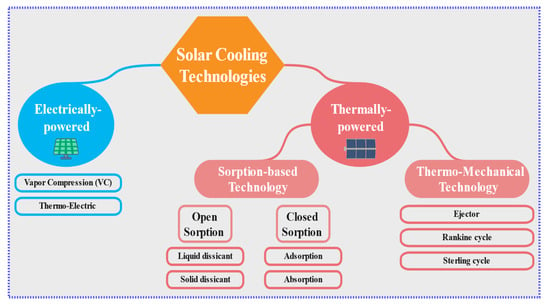
Figure 1.
Main solar cooling technologies.
The desalination process is known for its energy-intensive nature, in which the excess total dissolved solids (TDS) are eliminated either by water evaporation/condensation using thermal energy or by using membranes. The main commercial desalination technologies available worldwide can currently be classified into thermal technologies, such as multi-stage flash (MSF) and multi-effect distillation (MED) [29,30], or membrane-based technologies, such as reverse osmosis (RO) [31]. However, researchers have innovated many new and hybrid desalination technologies over the years to increase the efficiency of desalination technologies and reduce their energy requirements and carbon emissions. The main thermal and membrane desalination technologies are reported in Figure 2.
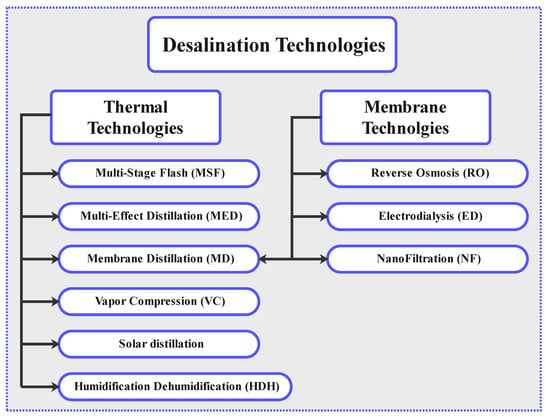
Figure 2.
Main desalination technologies reported in the literature.
According to the literature review, a limited number of reviews have summarized and reported on solar hybrid cooling and desalination systems. Therefore, this review summarizes recent studies for solar hybrid and cooling and desalination systems, and puts emphasis on their advantages over SP standalone systems in terms of energy and exergy efficiencies. Based on the perspectives above, this review paper summarizes and discusses state-of-the-art hybrid solar-powered desalination and cooling technologies. The paper is organized as follows: (i) Section 2 reports the recent advances in the integration of solar-powered adsorption desalination-cooling technologies; (ii) hybrid solar-powered RO desalination technologies with different cooling systems have been reviewed in Section 3; (iii) Section 4 summarizes the hybrid integration between solar-powered humidification-dehumidification (HDH) systems and different cooling technologies; (iv) Section 5 discusses the integration between MED system and different cooling technologies powered by solar energy; (v) Section 6 assesses the integration between solar-driven single-stage flash (SSF) desalination systems and various cooling technologies; (vi) membrane distillation (MD) desalination technologies integrated with different cooling systems are summarized in Section 7; (vii) and finally, the main conclusions and future recommendations are outlined in Section 9.
2. Solar Sorption Desalination/Cooling (SSDC) Systems
Thermally-powered sorption-based desalination and cooling systems, such as adsorption (SADDC) systems [32], have been considered by numerous researchers over the years to supply cooling and freshwater needs due to their many advantages. Their ability to be driven by low-temperature energy sources makes them perfect candidates for solar energy or waste heat utilization. Furthermore, adsorption-based systems have been reported to be able to supply cooling and fresh water by utilizing heat sources at temperatures as low as 50 °C [33]. These features have attracted numerous researchers to experimentally and theoretically investigate these systems to enhance their performance [34,35,36,37,38,39,40,41,42]. Various adsorbent materials have been developed to increase freshwater productivity and cooling production in adsorption systems [43,44,45,46,47]. The main examples of adsorbent materials used with water for adsorption desalination/cooling systems are silica gel (SG), Metal-Organic Frameworks (MOF), Zeolites, and activated carbons as innovative composite adsorbents to help improve the system performance [48,49,50,51,52].
Ng et al. [53] expressed the solar adsorption desalination-cooling (SADDC) cycle performance experimentally derived by solar collectors (SCs). The SADDC outcomes produced chilled water at 7–10 °C with a specific cooling power (SCP) from 25 to 35 RT/tonSG. Simultaneously, the SADDC system produces a specific daily water production (SDWP) from 3 to 5 m3/tonSG, with a performance ratio (PR) from 0.8 to 1.1. Alsaman et al. [54] designed a new proposed SADDC system, as illustrated in Figure 3, and experimentally tested it in Egypt’s weather conditions using a commercial SG as an adsorbent material. The SADDC outcomes reported that the average SCP, SDWP, and coefficient of performance (COP) were 112 W/kg, 4 m3/tonSG, and 0.45, respectively. The COP is defined as the evaporator capacity divided by driving energy input.
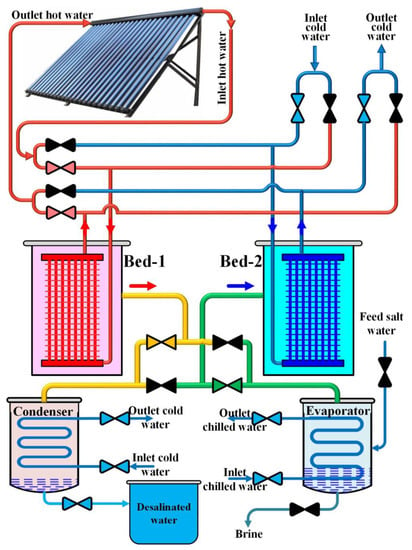
Figure 3.
Schematic diagram of the SADDC system (adapted from [54]).
Ali et al. [55] studied the effect of employing the SADDC system in Egypt’s weather conditions by using TRNSYS numerical software. The theoretical results revealed that the maximum SDWP, SCP, and COP were 10 m3/tonSG, 134 W/kg, and 0.5, respectively. The SDWP and SCP were increased by 70% using the optimum working conditions with the same system design and materials. Elsheniti et al. [56] explored the thermal and adsorption characteristics of aluminum fumarate (AL-Fum) MOF and SG adsorbents on the performance of the SADDC system. Raj and Baiju [57] studied SADDC operating and performance parameters under equilibrium conditions. The condenser, cooling, and regeneration temperatures significantly impacted water production (WP), COP, and energy consumption, as the highest SADDC outcomes could be achieved at the lowest cooling and condensation water temperatures and highest regeneration temperatures. Table 1 summarizes the main research regarding the adsorption desalination/cooling (ADC) systems.

Table 1.
Summary of main research covering ADC system performance.
3. Solar Reverse Osmosis/Cooling (SROC) Systems
Reverse osmosis desalination technology is currently the leading desalination system (60% worldwide) due to its economic performance compared to other conventional thermal desalination technologies, such as the MED and MSF technologies [10]. The RO desalination system is driven by electrical power to operate the high-pressure pumps. Consequently, RO systems are considered a perfect candidate to be powered by solar energy via the generated electricity by PV or PVT collectors [31,83]. Numerous researchers have investigated the integration of solar-powered conventional RO desalination systems and different cooling technologies to obtain a higher energy efficiency multigeneration system and/or increase its freshwater productivity.
Ali et al. [84] investigated a novel hybrid reverse osmosis-adsorption desalination and cooling (RO-AD) system, as shown in Figure 4, to evaluate the reutilizing of RO brine using an ADC unit for enhancing WP recovery by 25%. The RO-ADC system had a 100 W/kgSG SCP with a COP of 0.46. Hassan et al. [85] investigated an SROC system comprising PVT/evacuated tube hybrid solar collectors driving RO and adsorption chiller for cooling production under Alexandria, Egypt; climate conditions are illustrated in Figure 5. The system with 100% PVT collectors had annual energy savings of 32.95 MWh and an emissions cut of 18.06 tonCO2, with a 10.3 years payback period.
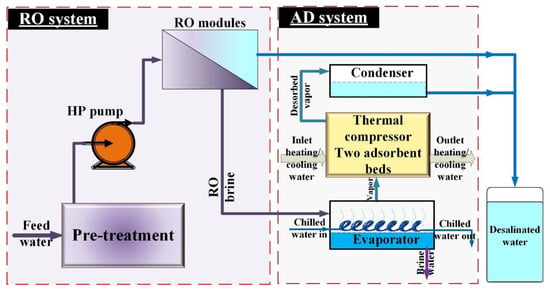
Figure 4.
The RO-ADC system diagram (Adapted from [84]).
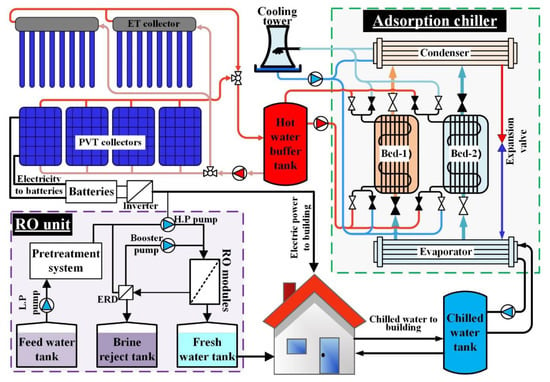
Figure 5.
SROC system (adapted from [85]).
Harby et al. [86] investigated a new hybrid RO-absorption desalination and cooling (RO-ABDC) system, as illustrated in Figure 6, to evaluate the reutilizing of RO brine using an ABDC unit for enhancing WP recovery. The results indicated an increase in RO-ABDC system recovery and water quality by about 72.86% and 59.3%, respectively, reducing electricity consumption by 49.1% compared to the single RO system. Additionally, the system can produce a 0.346 kW cooling capacity (CC), 0.77 COP, and 13.89 m3 potable water per day.
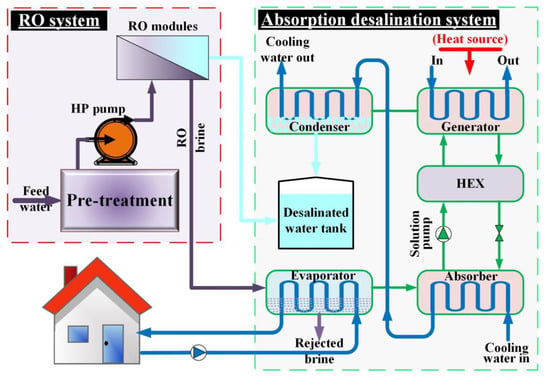
Figure 6.
The RO-ABDC system diagram (adapted from [86]).
Hunt et al. [87] investigated a combination of RO desalination and seawater air conditioning (SWAC) to produce drinkable and chilled water. The results found that the system can produce a CC of 49 MWth and desalinated water of 1 m3/s with 12 MWe electrical consumption (EC). Hussain [88] investigated a hybrid desalination-cooling system in Kuwait. The hybrid system was analyzed by integrating RO and MSF desalination systems with absorption refrigeration (ABR) and vapor compression (VC) refrigeration air conditioners. The hybrid RO-ABR system provided the highest fuel savings. Assareh et al. [89] investigated a hybrid RO-ABR system, as displayed in Figure 7. It provided potable water, cooling/hot water, and electricity. The study results illustrated that the system produced 9147 kW of electricity and 240.23 m3 of potable water. Additionally, the cost rate and the exergy efficiency (EEF) were 10.41 $/GJ and 20.52%, respectively.

Figure 7.
Schematic of multigeneration energy with a thermoelectric generator (TEG) for a hybrid RO-ABR system (adapted from [89]).
Abbasi et al. [90] studied a novel hybrid system using an RO desalination unit and ABR cycle for generating power, fresh water, and cooling. Energy storage by a Phase Change Material (PCM) was investigated for the night work. Organic Rankine Cycle (ORC) was employed to recover the gas turbine’s output heat (GT). The maximum EEF, energy, and total product cost rate were 14.40%, 40.52%, and 30.524 $/GJ, respectively. The CC and WP were about 1.62 MW and 5209.5 m3/day, respectively, with electricity of 2.4 MW. The electricity levelized cost was 0.234 $/kWh, demonstrating encouraging performance.
4. Solar Humidification-Dehumidification/Cooling (SHDC) Systems
The Humidification-Dehumidification (HDH) desalination system is one type of thermal desalination method that works similarly to the natural rain cycles and is usually used as a small-scale desalination technology that can work with different salinity levels. The HDH system comprises a humidifier, in which the air is moistened by direct contact with hot saline water. In the dehumidifier, the air is cooled with indirect contact with the cool saline water before it enters the humidifier, leading to the condensation of the freshwater [91,92]. Many researchers have attempted to integrate HDH with different cooling technologies to increase heat recovery in such systems and increase energy efficiency, while producing freshwater.
Several studies have investigated the benefits of the hybridization of VC-based cooling systems and HDH techniques for WP and conditioned air. Nada et al. [93] studied the performance of a hybrid desalination-cooling system employing the HDH and VC (HDH-VC) cycle. The evaporator surface works as a dehumidifier in the VC system to condensate the vapor, producing fresh and cooling water, as shown in Figure 8.
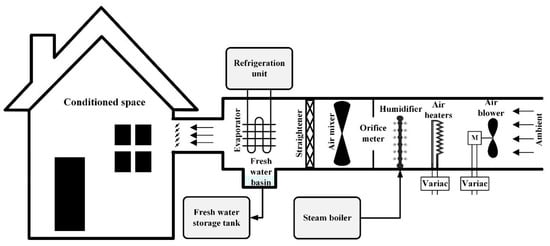
Figure 8.
The solar HDH-VC system (adapted from [93]).
Elattar et al. [94] evaluated solar hybrid HDH-air conditioning (AC) systems performance by integrating heat storage and heating systems for stable operation. Several designs and operating parameters explained WP rate and recovery, CC, power consumption, COP, and economic indicators. The results showed that the decreases in outdoor conditions (temperature and humidity) decreased the additional heater’s EC, opposite to the WP and recovery rates, CC, and the system power consumption. Compared with traditional systems in hot and humid regions, the results explained that the hybrid HDH-AC system has higher WP, CC, COP, and lower power consumption. Fouda et al. [95] theoretically investigated a solar hybrid HDH-AC system performance. The power, WP, CC, system COP, and water recovery were estimated as performance parameters. Additionally, Nada et al. [96] also studied HDH-VC system performance enhancement under dry and hot climatic conditions using an evaporative cooler, humidifier, and heat recovery unit at different arrangements. The results showed increased WP and power-saving by increasing the freshwater to recirculated air ratio and supplying air temperature.
Furthermore, other studies have investigated the integration between the cooling effect of the ABR system with HDH desalination systems for WP and conditioned air. For instance, Chiranjeevi and Srinivas [97,98,99,100] investigated the performance of a hybrid desalination-cooling system employing the HDH and ABR (HDH-ABR) cycle. First, dehumidifiers were used to produce fresh water in two stages. Next, the ABR cooling effect produced more fresh water and supplied the location adapted by conditioned air. Solar energy was used in the heat process for each HDH-ABR unit. The system produced two effects (desalination and cooling). The results indicated that the higher effectiveness of the humidifier and exit evaporator temperature improves the system performance and provides a higher temperature of saltwater with lower evaporator temperature.
Picinardi [101] investigated a hybrid HDH-ABR system’s water productivity and COP for desalination and cooling production with different water temperatures and mass flow rates. Almahmoud et al. [102] investigated a novel hybrid HDH-ejector refrigeration cycle (HDH-ERC) driven by solar energy. The results demonstrated that the ejector COP and entrainment ratio (ω) were 0.55 and 0.72, respectively. The entrainment ratio (ω) was the ratio between the mass flow rate coming from evaporator to the mass flow rate of fluid driving the ejector. The gained output ratio (GOR) and the WP for the HDH system were 2.76 and 20.58 L/h, respectively. Elbassoussi et al. [103] developed a novel hybrid HDH-adsorption desalination (AD) system to produce two effects (potable water and cooling) using low-grade heat sources. The system was driven by natural gas. At the same time, solar cells were used to run the blowers and pumps. The system WP was 21.75 kg per hour with a GOR of 2.50 (350% more than the standalone HDH). For the cooling effect, the CC and COP were 2.53 kW and 0.46, respectively. Significant savings of 30–40% in the cost of freshwater have also been achieved. Ali et al. [104] developed a novel hybrid solar-powered desalination system consisting of two ejectors (EJ), HDH, and AD systems, as shown in Figure 9. The system WP and GOR were 83.1 m3/tonSG per day and 2.76, respectively. The cost of WP was 1.49 $/m3.
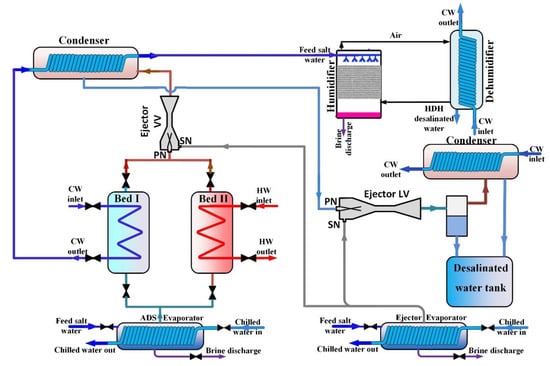
Figure 9.
The hybrid HDH-AD2EJ system (adapted from [104]).
Al-Mahmoud et al. [105] theoretically combined and studied a novel hybrid HDH-ERC system. The results showed an increase in the COP and ω by increasing the temperatures of each generator and evaporator, and vice versa with the condenser temperature. By increasing the HDH minimum temperature by 15 °C, the GOR was increased by 20%. Ghiasirad et al. [106] developed a hybrid HDH-ABR system driven by a geothermal heat source, as illustrated in Figure 10, for generating power, desalination, cooling, and heating. The results found that the HDH-ABR can produce power, WP, cooling, and heating of 78.5 kW, 92 m3 per day, 4991 kW, and 6251 kW, respectively.
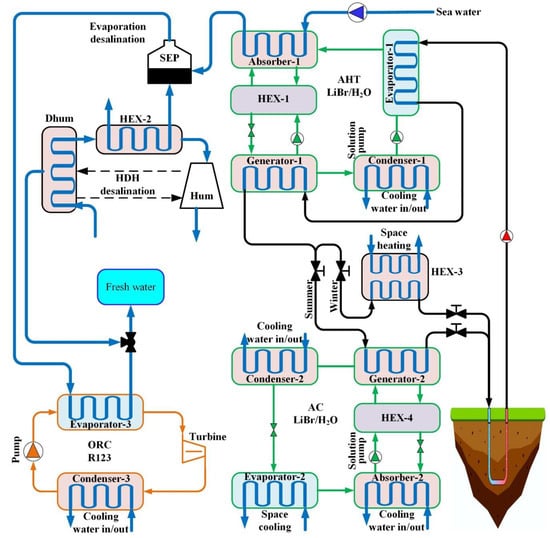
Figure 10.
A schematic of the HDH-ABR system (adapted from [106]).
Sadeghi et al. [107] analyzed a novel hybrid HDH-ERC system utilizing a zeotropic mixture working fluid. The HDH-ERC could produce power, CC, and total EEF of 52.2 kW and 120 kW, and 16.46%, respectively, slightly increasing distilled water. Habeebullah [108] investigated a hybrid dehumidification-heat pump (HP) experimentally to condensate the vapor from the atmospheric air in KSA. The hybrid system performance was examined for one year. The maximum WP was 2.23 m3/day in September, and the minimum WP was 0.618 m3/day in January. The average specific power rate was 0.42 kWh/liter of condensate water. The maximum water and electricity rate costs were 23 $/m3 and 0.045 $/kWh. Nada et al. [109] experimentally investigated a hybrid HDH-AC system with a strips-finned helical coil dehumidifier type and cellulose paper in a bee-hive structure pad type for high performance. The HDH-AC system has a better performance for WP and cooling compared to other systems. The WP, CC, COP, and WP-specific costs were 17.42 kg/h, 3.9 kW, 4.35, and 0.7 ¢/kg of water, respectively.
Xu et al. [110] experimentally developed a solar hybrid HDH-HP system. The maximum WP of the hybrid system was 12.38 kg/kWh at 0.3 m3/h cooling seawater flow rate and 450 m3/h process air flow rate. Lawal et al. [111] experimentally expressed HDH-HP system performance, as depicted in Figure 11. The hybrid system provides heat exchange between the HDH and HP as a condenser-humidifier and evaporator-dehumidifier to yield fresh water and cooling. System performance and cost were studied at different operating parameters (like flow rates and temperatures). The maximum GOR, RR, COP, energy utilization factor, and WP values were 4.07, 4.86%, 4.85, 3.04, and 287.8 L/day, respectively, with a minimum specific electrical energy consumption of 160.16 kWh/m3 of freshwater. In addition, the hybrid system gave a CC of 3.07 kW. 10.68–20.39 US$/m3 of freshwater as the price of water production.
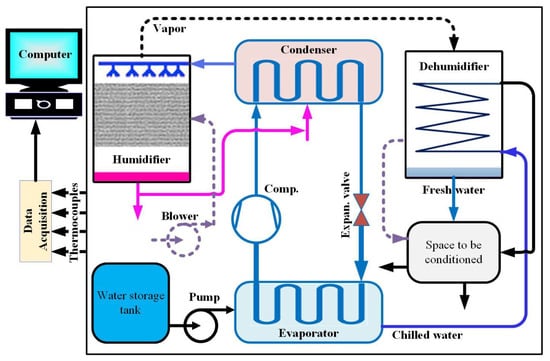
Figure 11.
Schematic diagram of experimental HDH-HP (adapted from [111]).
5. Solar Multi-Effect Distillation/Cooling (SMEDC) Systems
MED is one of the first thermal desalination techniques widely used in industry. The basic working principle is that the saline water is sprayed over a tube bundle to be heated at low operating pressure by the steam generated in the previous stage flowing inside these tubes, leading to the evaporation of water vapor, which is condensed in the last stages by cool saline water to form the freshwater [112].
Numerous researchers have investigated the integration of solar-driven MED units with various cooling technologies to make use of the excess thermal energy used to drive the MED units instead of wasting it to the surrounding environment, thus increasing system overall energy efficiency. Abdelhay et al. [113] numerically developed a hybrid solar desalination-cooling system employing a MED unit with an ABR system, as expressed in Figure 12. The solar power system (SPS) was a parabolic trough collector (PTC) unit, which uses thermal oil and ORC. In addition to a backup heater running on natural gas. ARS and MED units were driven by turbine-rejected steam. The first steam stream drove the ARS system, while the other steam line was adjusted before driving the MED system with the required heat. A hot well was used to collect MED, ARS, and condenser, and then the condensate was returned to the boiler. The hybrid system (SPS-ABR-MED) was developed to serve about a thousand residential homes. The operating parameters and design effects on the exergetic and plant energetics have been presented. The suitable area for PTC can be determined by selecting the capacities of the units (ABR, MED, and SPS) dependent on the flow rate of the steam condenser. Due to the heater, the highest percentage of total costs and operational expenditure was 54.83% and 87.68%, respectively. The hybrid system provides the lowest price for water and cooling production of 1.247 $/m3 and 0.003 $/kW hr, respectively, with 23.95% exergetic efficiency compared to the single desalination and cooling systems or without solar system.
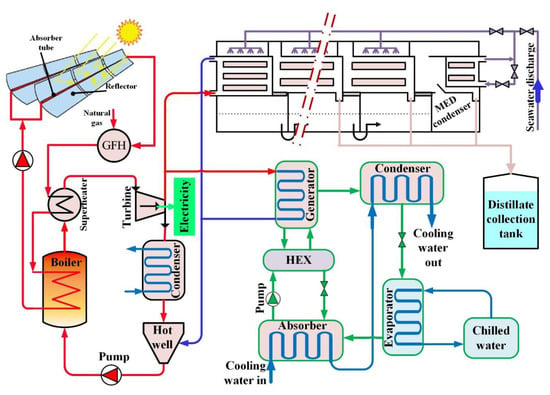
Figure 12.
The hybrid SPS-ABR-MED system (adapted from [113]).
Kerme et al. [114] developed a theoretical analysis of the solar distillation-cooling system. The system includes a MED, ABR unit, and ORC with PTCs as thermal energy sources. The study includes many examinations, analyses, and effects on the proposed system, such as power configurations, turbine and pump inlet temperatures, total exergy loss, fuel depletion ratio, and improvement potential. The results showed that the performance increases and total exergy reduces by increasing the inlet temperature of the turbine; 49.3% and 9.6% of the input exergy destructed in the collector and desalination systems, respectively. The overall system improvement percentage was 64.8%. Mehrpooya et al. [115] studied an integrated system of desalination and refrigeration powered by solar energy. The system consists of a MED and ABR system with parabolic collectors and a steam turbine as a thermal energy source. The ABR and MED cycles produced a refrigeration power of 820.8 kW and potable water of 22.79 kg/s. The results also illustrated that the total cycle electrical energy efficiency and the total net thermal efficiency of the integrated system were 66.05%, and 80.70%, respectively. The integrated system had 5.738 years as an investment return period and 6.828 million US$ as a net annual profit per year.
Sahoo et al. [116] proposed hybrid solar–biomass power-based desalination-cooling and heating, as shown in Figure 13, to overcome renewable energy intermittence and reduce the greenhouse gas emissions and cost of power generation. The results showed decreased turbine output due to steam extraction from the turbine for ABR cooling and slightly declined COP. The net energy equivalent increased to 18.24% compared to a simple power plant with low CO2 emissions. The initial energy savings were brought to 15.3% for the hybrid system.
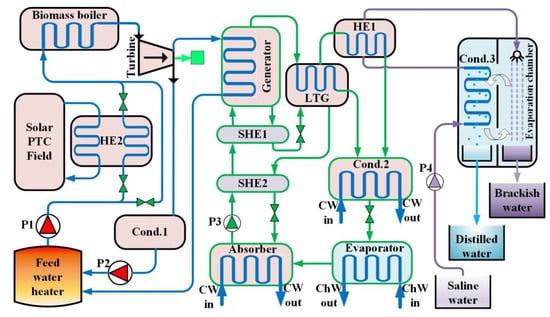
Figure 13.
Schematic solar–biomass power with the desalination-cooling process (adapted from [116]).
Sahoo et al. [117] developed an innovative hybrid desalination-cooling system driven by solar-biomass to achieve higher energy efficiency and reduce greenhouse gas emissions. The desalination-cooling system consists of MED, HDH, and ABR cycles. System initial energy savings were achieved by 50.5%. The power output was increased to 78.12% compared to the simple power plant. Aly et al. [118] presented a novel integration of MED-ABR in Qatar to reduce cost and energy consumption. For the MED-ABR plant with a 25 m3/day capacity, the specific energy consumption (SEC) was 4.8 kWh/m3, lower than the MED-thermal vapor compression (TVC) plant of 60% (13 kWh/m3). The results also illustrated that the MED-ABR pumping power and the feed seawater were 55% and 70%, respectively, lower than MED-TVC. The MED-ABR unit cost was 0.46 $/m3 (22% lower than the MED-TVC). Son et al. [119] investigated a MED-AD hybrid system in KAUST, KSA, illustrated in Figure 14, to maximize energy input utilization in desalination. The WP and PR were 2–5 times enhanced to the MED. The developed MED-AD hybrid system demonstrated its applicability to industrial processes.
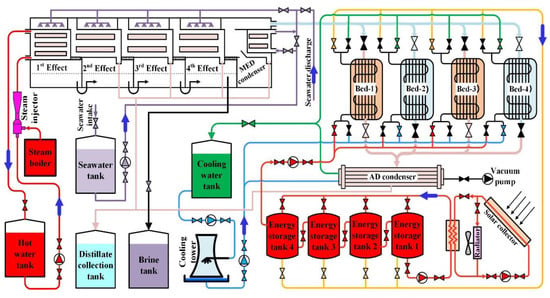
Figure 14.
Schematic of a hybrid MED-AD system (adapted from [119]).
6. Solar Single-Stage Flash/Cooling (SSSFC) Systems
The single and multi-stage flash (SSF and MSF) desalination technologies were developed to overcome some drawbacks of MED, such as the scale formation and corrosion on the tubes that increases the resistance to the heat transfer between steam and saline water, and thus reducing plant efficiency and lifetime. Consequently, MED operation is limited to driving temperatures in MED below 80 °C to overcome these problems [120,121]. However, this low-driving temperature gives the MED technologies lower thermal power consumption and more suitable solar energy and waste heat at temperatures below 100 °C. The MSF technology is the dominant thermal desalination technology. It mainly depends on heating the feed saline water in one or more stages to above 100 °C, then letting it flows in consecutive stages at low pressures leading to flashing of water vapor that is condensed by the feed saline water to allow thermal energy recovery and increase system efficiency. However, some researchers have only investigated a single-stage flash system to make it more suitable for solar energy utilization with a similar operating principle [122,123]. The saline feed water is heated, and then flashing occurs with the help of an expansion valve to separate the generated water vapor and the liquid brine.
Many studies have considered integrating solar-driven SSF desalination technology with different cooling technologies. Hogerwaard et al. [124] integrated a solar-driven gas turbine (SGT) with an ORC, an ABR system, and SSF desalination. The waste heat from the compressor and exhaust streams was exploited as a heat source for the ABR system generator, desalination process, and ORC boiler. The system indicated 0.27 and 0.284 exergetic and energetic efficiencies, respectively. Furthermore, the desalination process provided other commodities like cooling and hot water, and secondary power generation.
Velázquez-Limón et al. [125] investigated a solar-driven hybrid SSF/ABR system for a hotel, as illustrated in Figure 15. The SSF/ABR system comprised an open cycle absorption cooling system, in which the saline feed water was used as the cooling water for the ABR cycle. It passed through the SSF, where the water vapor was absorbed in the ABR absorber to be extracted after the ABR evaporator using an ejector. The results showed a 13.88% increase in ABR average COP, while the SSF desalination performance ratio was about 0.83.
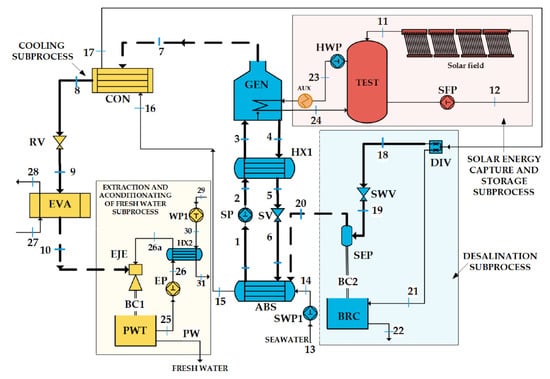
Figure 15.
Schematic diagram of the solar-powered SSF/ABR hybrid system (adapted from [125]).
7. Solar Membrane Distillation/Cooling (SMDC) Systems
MD is a thermal desalination technology in which a porous membrane is used to separate the water vapor, which is allowed to pass through the membrane, and the hot saline water, which is not allowed to pass. Then, the water vapor is condensed to form the produced freshwater [126,127]. Many studies have investigated solar-powered MD systems integrated with various cooling technologies to increase overall system energy efficiency while supplying cooling and freshwater needs. Mohan et al. [128] investigated a new hybrid desalination-cooling-heating system powered by solar energy by different SC types in the United Arab Emirates weather conditions. The hybrid system included a solar energy unit, ABR, and MD modules, as shown in Figure 16. The system optimizes various design parameters (like water mass flow rate, slope, area of the collectors, and storage capacity). The lowest recovery period was achieved with 216 m2 of evacuated tube SCs (6.75 years). The system saves 520,000$ throughout the project life. The system can produce a CC of the ABR of about 35 kW and freshwater 80 liters per day from the MD unit with heat recovery of 1.2 m3/h per year.
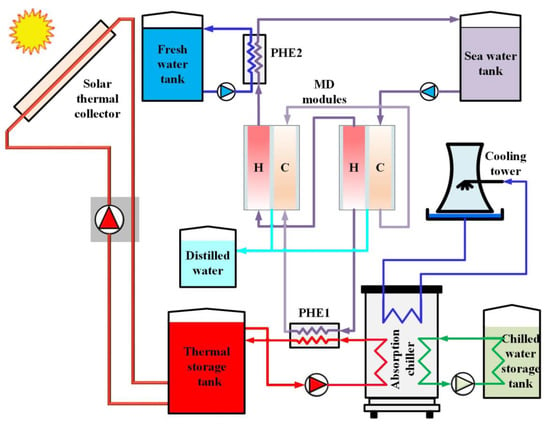
Figure 16.
Schematic layout of solar MD-ABR system (adapted from [128]).
Byrne et al. [129] developed a theoretical model of a hybrid MD-HP for a desalination-cooling system to estimate producing the potable water depending on a refrigerator cooling load. The results showed that the hybrid MD-HP system offers more exciting perspectives than the RO plant for the same WP with a HP with the same cooling load. Ghaffour et al. [61] by solar energy, geothermal, or waste heat. The results showed a SEC of the MD-AD system of less than 1.5 kWhe/m3 with 8 m3 per day solar-driven AD cycle. Shafieian et al. [130] theoretically studied a novel MD-ABR system powered by wasted heat from exhaust fumes and heat from cooling submarine engines. The results showed that the optimum cooling power was 160 kW at diesel exhaust mass ratio and the refrigerant mass flow rate in the ranges of 0.8–0.95 and 0.27–0.34 kg/s, respectively. Ayou et al. [131] numerically studied the energy and exergy performance of a hybrid MD-ABR system powered by renewable energy (solar collector and biomass-fired) to provide WP, CC, and electricity. The system produced WP, CC, and electricity of 41.4 m3/day, 130 kW at 11 °C, and 6.4 kW, respectively. The results showed that the hybrid system could increase thermal energy conversion efficiency and decrease the effective cost of using solar energy.
8. Comparison between Different Reported Hybrid Desalination/Cooling Systems
Table 2 summarizes the main research studies on hybrid solar desalination/cooling systems. The table shows available systems performance indicators, such as water production, cooling capacity, COP, and water cost. According to the review, the lowest cost of water production is 0.455 $/m3 Aly et al. [122] for the hybrid MED-ABR system.

Table 2.
Summary of main research covering the performance of hybrid solar desalination/cooling systems.
9. Conclusions and Future Recommendations
This study reported on the state-of-the-art solar-driven hybrid desalination/cooling systems. Numerous studies have presented thermal and membrane desalination technologies, such as RO, MED, SSF, MD, and adsorption, absorption desalination, and HDH systems, and their integrations powered by solar energy were summarized. System performance indicators, such as water production rate, cooling capacity, COP, and water cost were presented to compare between these technologies. According to the review, the HDH-AC system had the highest COP of 4.35, at a specific water production cost of 0.7 ¢/kg. The lowest cost of water production was 0.455 $/m3 for the hybrid MED-ABR system. The paper recommends the following points to be addressed in future research:
The study of more adsorbent materials to enhance solar adsorption desalination system performance and increase the fresh water and desalination effects.
Experimentally study theoretical combinations, such as AD-RO, AD-HDH, ABR-RO, and AD-EJ to realize their performance.
Set up a pilot scale and cost study of these solar hybrid systems to attract investors.
Funding
This research was funded by Science, Technology and Innovation Funding Authority (STDF) through Call 8/Innovation Grants (STDF-IG)/Development and Innovation Grants. Grant project No. 43579.
Conflicts of Interest
The authors declare no conflict of interest.
Abbreviations
| ABR | Absorption Refrigeration |
| ABDC | Absorption Desalination and Cooling |
| AC | Air Conditioning |
| AD | Adsorption Desalination |
| ADC | Adsorption Desalination Cooling |
| Al-Fum | Aluminum Fumarate |
| AWH | Atmospheric Water Harvesting |
| CC | Cooling Capacity |
| COP | Coefficient of Performance |
| EC | Electrical Consumption |
| EEF | Exergy Efficiency |
| ERC | Ejector Refrigeration Cycle |
| EJ | Ejector |
| GT | Gas Turbine |
| GW | Global Warming |
| GOR | Gained Output Ratio |
| HDH | Humidification-Dehumidification |
| HP | Heat Pump |
| HVAC | Heating, Ventilation and Air Conditioning |
| HWT | Hot Water Temperature |
| MD | Membrane Distillation |
| MED | Multi-Effect Distillation |
| MOF | Metal-Organic Frameworks |
| MSF | Multi-Effect Flash |
| MWCNT | Multi-Walled Carbon Nanotube |
| NF | Nano Filtration |
| ORC | Organic Rankine Cycle |
| PCM | Phase Change Material |
| PR | Performance Ratio |
| PTC | Parabolic Trough Collector |
| PV | Photovoltaic |
| PVT | Photovoltaic/Thermal |
| RO | Reverse Osmosis |
| RT | Refrigeration Ton |
| SADDC | Solar Adsorption Desalination/Cooling |
| SDWP | Specific Daily Water Production |
| SC | Solar Collector |
| SCP | Specific Cooling Capacity |
| SEC | Specific Energy Consumption |
| SG | Silica gel |
| SGT | Solar-Driven Gas Turbine |
| SHDC | Solar Humidification-Dehumidification/Cooling |
| SMDC | Solar Membrane Distillation/Cooling |
| SMEDC | Solar Multi-Effect Distillation/Cooling |
| SP | Separate Production |
| SROC | Solar Reverse Osmosis/Cooling |
| SPS | Solar Power System |
| SSF | Single Stage Flash |
| SSDC | Solar Sorption Desalination/Cooling |
| SSSFC | Solar Single-Stage Flash/Cooling |
| SWAC | Seawater Air Conditioning |
| TDS | Total Dissolved Solids |
| TEG | Thermoelectric generator |
| TVC | Thermal Vapor Compression |
| VC | Vapor Compression |
| WP | Water Production |
References
- Aghahosseini, A.; Bogdanov, D.; Breyer, C. Towards Sustainable Development in the MENA Region: Analysing the Feasibility of a 100% Renewable Electricity System in 2030. Energy Strategy Rev. 2020, 28, 100466. [Google Scholar] [CrossRef]
- Al-Ghussain, L. Global Warming: Review on Driving Forces and Mitigation. Environ. Prog. Sustain. Energy 2019, 38, 13–21. [Google Scholar] [CrossRef]
- Wuebbles, D.J.; Jain, A.K. Concerns about Climate Change and the Role of Fossil Fuel Use. Fuel Process. Technol. 2001, 71, 99–119. [Google Scholar] [CrossRef]
- Randazzo, T.; De Cian, E.; Mistry, M.N. Air Conditioning and Electricity Expenditure: The Role of Climate in Temperate Countries. Econ. Model. 2020, 90, 273–287. [Google Scholar] [CrossRef]
- Gleick, P.H. Water in Crisis: A Guide to the World’s Freshwater Resources; Oxford University Press: New York, NY, USA, 1993; Volume 100. [Google Scholar]
- Sosnowski, M.; Krzywanski, J.; Skoczylas, N. Adsorption Desalination and Cooling Systems: Advances in Design, Modeling and Performance. Energies 2022, 15, 4036. [Google Scholar] [CrossRef]
- Ejeian, M.; Wang, R.Z. Adsorption-Based Atmospheric Water Harvesting. Joule 2021, 5, 1678–1703. [Google Scholar] [CrossRef]
- Gado, M.G.; Nasser, M.; Hassan, A.A.; Hassan, H. Adsorption-Based Atmospheric Water Harvesting Powered by Solar Energy: Comprehensive Review on Desiccant Materials and Systems. Process Saf. Environ. Prot. 2022, 160, 166–183. [Google Scholar] [CrossRef]
- Ng, K.C.; Thu, K.; Oh, S.J.; Ang, L.; Shahzad, M.W.; Ismail, A. Bin Recent Developments in Thermally-Driven Seawater Desalination: Energy Efficiency Improvement by Hybridization of the MED and AD Cycles. Desalination 2015, 356, 255–270. [Google Scholar] [CrossRef]
- Qasim, M.; Badrelzaman, M.; Darwish, N.N.; Darwish, N.A.; Hilal, N. Reverse Osmosis Desalination: A State-of-the-Art Review. Desalination 2019, 459, 59–104. [Google Scholar] [CrossRef]
- Shahzad, M.W.; Burhan, M.; Ang, L.; Ng, K.C. Energy-Water-Environment Nexus Underpinning Future Desalination Sustainability. Desalination 2017, 413, 52–64. [Google Scholar] [CrossRef]
- Byrne, P.; Fournaison, L.; Delahaye, A.; Ait Oumeziane, Y.; Serres, L.; Loulergue, P.; Szymczyk, A.; Mugnier, D.; Malaval, J.L.; Bourdais, R.; et al. A Review on the Coupling of Cooling, Desalination and Solar Photovoltaic Systems. Renew. Sustain. Energy Rev. 2015, 47, 703–717. [Google Scholar] [CrossRef]
- Hassan, A.A.; Elwardany, A.E.; Ookawara, S.; Sekiguchi, H.; Hassan, H. Energy, Exergy, Economic and Environmental (4E) Assessment of Hybrid Solar System Powering Adsorption-Parallel/Series ORC Multigeneration System. Process Saf. Environ. Prot. 2022, 164, 761–780. [Google Scholar] [CrossRef]
- Hassan, A.A.; Elwardany, A.E.; Ookawara, S.; El-Sharkawy, I.I. Performance Investigation of a Solar-Powered Adsorption-Based Trigeneration System for Cooling, Electricity, and Domestic Hot Water Production. Appl. Therm. Eng. 2021, 199, 117553. [Google Scholar] [CrossRef]
- Hosenuzzaman, M.; Rahim, N.A.; Selvaraj, J.; Hasanuzzaman, M.; Malek, A.B.M.A.; Nahar, A. Global Prospects, Progress, Policies, and Environmental Impact of Solar Photovoltaic Power Generation. Renew. Sustain. Energy Rev. 2015, 41, 284–297. [Google Scholar] [CrossRef]
- Rahman, A.; Farrok, O.; Haque, M.M. Environmental Impact of Renewable Energy Source Based Electrical Power Plants: Solar, Wind, Hydroelectric, Biomass, Geothermal, Tidal, Ocean, and Osmotic. Renew. Sustain. Energy Rev. 2022, 161, 112279. [Google Scholar] [CrossRef]
- Hassan, A.A.; Elwardany, A.E.; Ookawara, S.; El-Sharkawy, I.I. Performance Investigation of Integrated PVT/Adsorption Cooling System under the Climate Conditions of Middle East. Energy Rep. 2020, 6, 168–173. [Google Scholar] [CrossRef]
- Hassan, A.A.; Elwardany, A.E.; Ookawara, S.; Ahmed, M.; El-Sharkawy, I.I. Integrated Adsorption-Based Multigeneration Systems: A Critical Review and Future Trends. Int. J. Refrig. 2020, 116, 129–145. [Google Scholar] [CrossRef]
- Zaki, O.M.; Mohammed, R.H.; Abdelaziz, O. Separate Sensible and Latent Cooling Technologies: A Comprehensive Review. Energy Convers. Manag. 2022, 256, 115380. [Google Scholar] [CrossRef]
- Ghazy, M.; Ibrahim, E.M.M.; Mohamed, A.S.A.; Askalany, A.A. Cooling Technologies for Enhancing Photovoltaic–Thermal (PVT) Performance: A State of the Art. Int. J. Energy Environ. Eng. 2022. [Google Scholar] [CrossRef]
- She, X.; Cong, L.; Nie, B.; Leng, G.; Peng, H.; Chen, Y.; Zhang, X.; Wen, T.; Yang, H.; Luo, Y. Energy-Efficient and -Economic Technologies for Air Conditioning with Vapor Compression Refrigeration: A Comprehensive Review. Appl. Energy 2018, 232, 157–186. [Google Scholar] [CrossRef]
- Harby, K.; Gebaly, D.R.; Koura, N.S.; Hassan, M.S. Performance Improvement of Vapor Compression Cooling Systems Using Evaporative Condenser: An Overview. Renew. Sustain. Energy Rev. 2016, 58, 347–360. [Google Scholar] [CrossRef]
- Cai, Y.; Wang, Y.; Liu, D.; Zhao, F.Y. Thermoelectric Cooling Technology Applied in the Field of Electronic Devices: Updated Review on the Parametric Investigations and Model Developments. Appl. Therm. Eng. 2019, 148, 238–255. [Google Scholar] [CrossRef]
- Pourkiaei, S.M.; Ahmadi, M.H.; Sadeghzadeh, M.; Moosavi, S.; Pourfayaz, F.; Chen, L.; Pour Yazdi, M.A.; Kumar, R. Thermoelectric Cooler and Thermoelectric Generator Devices: A Review of Present and Potential Applications, Modeling and Materials. Energy 2019, 186, 115849. [Google Scholar] [CrossRef]
- Chauhan, P.R.; Kaushik, S.C.; Tyagi, S.K. Current Status and Technological Advancements in Adsorption Refrigeration Systems: A Review. Renew. Sustain. Energy Rev. 2022, 154, 111808. [Google Scholar] [CrossRef]
- Hara Chakravarty, K.; Sadi, M.; Chakravarty, H.; Sulaiman Alsagri, A.; James Howard, T.; Arabkoohsar, A. A Review on Integration of Renewable Energy Processes in Vapor Absorption Chiller for Sustainable Cooling. Sustain. Energy Technol. Assess. 2022, 50, 101822. [Google Scholar] [CrossRef]
- Kasaeian, A.; Shamaeizadeh, A.; Jamjoo, B. Combinations of Rankine with Ejector Refrigeration Cycles: Recent Progresses and Outlook. Appl. Therm. Eng. 2022, 211, 118382. [Google Scholar] [CrossRef]
- Braimakis, K. Solar Ejector Cooling Systems: A Review. Renew Energy 2021, 164, 566–602. [Google Scholar] [CrossRef]
- Mohammed, R.H.; Ibrahim, M.M.; Abu-Heiba, A. Exergoeconomic and Multi-Objective Optimization Analyses of an Organic Rankine Cycle Integrated with Multi-Effect Desalination for Electricity, Cooling, Heating Power, and Freshwater Production. Energy Convers. Manag. 2021, 231, 113826. [Google Scholar] [CrossRef]
- Elsayed, M.L.; Mesalhy, O.; Mohammed, R.H.; Chow, L.C. Exergy and Thermo-Economic Analysis for MED-TVC Desalination Systems. Desalination 2018, 447, 29–42. [Google Scholar] [CrossRef]
- Shemer, H.; Semiat, R. Sustainable RO Desalination—Energy Demand and Environmental Impact. Desalination 2017, 424, 10–16. [Google Scholar] [CrossRef]
- Sztekler, K.; Kalawa, W.; Mika, L.; Lis, L.; Radomska, E.; Nowak, W. The Effects of Using Steam to Preheat the Beds of an Adsorption Chiller with Desalination Function. Energies 2021, 14, 6454. [Google Scholar] [CrossRef]
- Pan, Q.; Peng, J.; Wang, R. Experimental Study of an Adsorption Chiller for Extra Low Temperature Waste Heat Utilization. Appl. Therm. Eng. 2019, 163, 114341. [Google Scholar] [CrossRef]
- Saha, B.B.; El-Sharkawy, I.I.; Shahzad, M.W.; Thu, K.; Ang, L.; Ng, K.C. Fundamental and Application Aspects of Adsorption Cooling and Desalination. Appl. Therm. Eng. 2016, 97, 68–76. [Google Scholar] [CrossRef]
- Makhanya, N.; Oboirien, B.; Ren, J.; Musyoka, N.; Sciacovelli, A. Recent Advances on Thermal Energy Storage Using Metal-Organic Frameworks (MOFs). J. Energy Storage 2021, 34, 102179. [Google Scholar] [CrossRef]
- Ali, E.S.; Muhammad Asfahan, H.; Sultan, M.; Askalany, A.A. A Novel Ejectors Integration with Two-Stages Adsorption Desalination: Away to Scavenge the Ambient Energy. Sustain. Energy Technol. Assess. 2021, 48, 101658. [Google Scholar] [CrossRef]
- Zohir, A.E.; Ali, E.S.; Farid, A.M.; Elshaer, R.N.; Mohammed, R.H.; Alsaman, A.S.; El-Ghetany, H.H.; Askalany, A.A. A State-of-the-Art of Experimentally Studied Adsorption Water Desalination Systems. Int. J. Energy Environ. Eng. 2022. [Google Scholar] [CrossRef]
- Sztekler, K.; Siwek, T.; Kalawa, W.; Lis, L.; Mika, L.; Radomska, E.; Nowak, W. CFD Analysis of Elements of an Adsorption Chiller with Desalination Function. Energies 2021, 14, 7804. [Google Scholar] [CrossRef]
- Sztekler, K.; Kalawa, W.; Mika, Ł.; Sowa, M. Effect of Metal Additives in the Bed on the Performance Parameters of an Adsorption Chiller with Desalination Function. Energies 2021, 14, 7226. [Google Scholar] [CrossRef]
- Sztekler, K.; Mika, Ł. Increasing the Performance of an Adsorption Chiller Operating in the Water Desalination Mode. Energies 2021, 14, 7743. [Google Scholar] [CrossRef]
- Sztekler, K. Optimisation of Operation of Adsorption Chiller with Desalination Function. Energies 2021, 14, 2668. [Google Scholar] [CrossRef]
- Sztekler, K.; Kalawa, W.; Nowak, W.; Mika, L.; Gradziel, S.; Krzywanski, J.; Radomska, E. Experimental Study of Three-Bed Adsorption Chiller with Desalination Function. Energies 2020, 13, 5827. [Google Scholar] [CrossRef]
- Younes, M.M.; El-Sharkawy, I.I.; Kabeel, A.E.; Saha, B.B. A Review on Adsorbent-Adsorbate Pairs for Cooling Applications. Appl. Therm. Eng. 2017, 114, 394–414. [Google Scholar] [CrossRef]
- Alsaman, A.S.; Ibrahim, E.M.M.; Ahmed, M.S.; Askalany, A.A. Composite Adsorbent Materials for Desalination and Cooling Applications: A State of the Art. Int. J. Energy Res. 2022, 46, 10345–10371. [Google Scholar] [CrossRef]
- Alsaman, A.S.; Ibrahim, E.M.M.; Askalany, A.A.; Farid, A.M.; Ali, E.S.; Ahmed, M.S. Composite Material-Based a Clay for Adsorption Desalination and Cooling Applications. Chem. Eng. Res. Des. 2022, 188, 417–432. [Google Scholar] [CrossRef]
- Alsaman, A.S.; Ibrahim, E.M.M.; Salem Ahmed, M.; Ali, E.S.; Farid, A.M.; Askalany, A.A. Experimental Investigation of Sodium Polyacrylate-Based Innovative Adsorbent Material for Higher Desalination and Cooling Effects. Energy Convers. Manag. 2022, 266, 115818. [Google Scholar] [CrossRef]
- Alsaman, A.S.; Askalany, A.A.; Ibrahim, E.M.M.; Farid, A.M.; Ali, E.S.; Ahmed, M.S. Characterization and Cost Analysis of a Modified Silica Gel-Based Adsorption Desalination Application. J. Clean. Prod. 2022, 379, 134614. [Google Scholar] [CrossRef]
- Rocky, K.A.; Pal, A.; Rupam, T.H.; Palash, M.L.; Saha, B.B. Recent Advances of Composite Adsorbents for Heat Transformation Applications. Therm. Sci. Eng. Prog. 2021, 23, 100900. [Google Scholar] [CrossRef]
- Mohammed, R.H.; Rezk, A.; Askalany, A.; Ali, E.S.; Zohir, A.E.; Sultan, M.; Ghazy, M.; Abdelkareem, M.A.; Olabi, A.G. Metal-Organic Frameworks in Cooling and Water Desalination: Synthesis and Application. Renew. Sustain. Energy Rev. 2021, 149, 111362. [Google Scholar] [CrossRef]
- Ali, E.S.; Mohammed, R.H.; Zohir, A.E.; Farid, A.M.; Elshaer, R.N.; El-Ghetany, H.H.; Askalany, A.A. Novel Ultrasonic Dynamic Vapor Sorption Apparatus for Adsorption Drying, Cooling and Desalination Applications. Energy Rep. 2022, 8, 8798–8804. [Google Scholar] [CrossRef]
- Sztekler, K.; Mlonka-Mędrala, A.; Khdary, N.H.; Kalawa, W.; Nowak, W.; Mika, Ł. Possibility of Advanced Modified-Silica-Based Porous Materials Utilisation in Water Adsorption Processes—A Comparative Study. Energies 2022, 15, 368. [Google Scholar] [CrossRef]
- Solovyeva, M.; Krivosheeva, I.; Gordeeva, L.; Aristov, Y. MIL-160 as an Adsorbent for Atmospheric Water Harvesting. Energies 2021, 14, 3586. [Google Scholar] [CrossRef]
- Ng, K.C.; Thu, K.; Chakraborty, A.; Saha, B.B.; Chun, W.G. Solar-Assisted Dual-Effect Adsorption Cycle for the Production of Cooling Effect and Potable Water. Int. J. Low-Carbon Technol. 2009, 4, 61–67. [Google Scholar] [CrossRef]
- Alsaman, A.S.; Askalany, A.A.; Harby, K.; Ahmed, M.S. Performance Evaluation of a Solar-Driven Adsorption Desalination-Cooling System. Energy 2017, 128, 196–207. [Google Scholar] [CrossRef]
- Ali, E.S.; Harby, K.; Askalany, A.A.; Diab, M.R.; Alsaman, A.S. Weather Effect on a Solar Powered Hybrid Adsorption Desalination-Cooling System: A Case Study of Egypt’s Climate. Appl. Therm. Eng. 2017, 124, 663–672. [Google Scholar] [CrossRef]
- Elsheniti, M.B.; Rezk, A.; Shaaban, M.; Roshdy, M.; Nagib, Y.M.; Elsamni, O.A.; Saha, B.B. Performance of a Solar Adsorption Cooling and Desalination System Using Aluminum Fumarate and Silica Gel. Appl. Therm. Eng. 2021, 194, 117116. [Google Scholar] [CrossRef]
- Raj, R.; Baiju, V. Thermodynamic Analysis of a Solar Powered Adsorption Cooling and Desalination System. Energy Procedia 2019, 158, 885–891. [Google Scholar] [CrossRef]
- Ng, K.C.; Thu, K.; Saha, B.B.; Chakraborty, A. Study on a Waste Heat-Driven Adsorption Cooling Cum Desalination Cycle. Int. J. Refrig. 2012, 35, 685–693. [Google Scholar] [CrossRef]
- Olkis, C.; Brandani, S.; Santori, G. Cycle and Performance Analysis of a Small-Scale Adsorption Heat Transformer for Desalination and Cooling Applications. Chem. Eng. J. 2019, 378, 122104. [Google Scholar] [CrossRef]
- Olkis, C.; Brandani, S.; Santori, G. Design and Experimental Study of a Small Scale Adsorption Desalinator. Appl. Energy 2019, 253, 113584. [Google Scholar] [CrossRef]
- Ghaffour, N.; Lattemann, S.; Missimer, T.; Ng, K.C.; Sinha, S.; Amy, G. Renewable Energy-Driven Innovative Energy-Efficient Desalination Technologies. Appl. Energy 2014, 136, 1155–1165. [Google Scholar] [CrossRef]
- Mitra, S.; Srinivasan, K.; Kumar, P.; Murthy, S.S.; Dutta, P. Solar Driven Adsorption Desalination System. Energy Procedia 2014, 49, 2261–2269. [Google Scholar] [CrossRef]
- Youssef, P.G.; Al-Dadah, R.K.; Mahmoud, S.M.; Dakkama, H.J.; Elsayed, A. Effect of Evaporator and Condenser Temperatures on the Performance of Adsorption Desalination Cooling Cycle. Energy Procedia 2015, 75, 1464–1469. [Google Scholar] [CrossRef]
- Youssef, P.G.; Mahmoud, S.M.; AL-Dadah, R.K. Performance Analysis of Four Bed Adsorption Water Desalination/Refrigeration System, Comparison of AQSOA-Z02 to Silica-Gel. Desalination 2015, 375, 100–107. [Google Scholar] [CrossRef]
- Wang, X.; Ng, K.C. Experimental Investigation of an Adsorption Desalination Plant Using Low-Temperature Waste Heat. Appl. Therm. Eng. 2005, 25, 2780–2789. [Google Scholar] [CrossRef]
- Ali, E.S.; Mohammed, R.H.; Askalany, A. A Daily Freshwater Production of 50 M3/Ton of Silica Gel Using an Adsorption-Ejector Combination Powered by Low-Grade Heat. J. Clean. Prod. 2021, 282, 124494. [Google Scholar] [CrossRef]
- Li, M.; Zhao, Y.; Long, R.; Liu, Z.; Liu, W. Field Synergy Analysis for Heat and Mass Transfer Characteristics in Adsorption-Based Desalination and Cooling Systems. Desalination 2021, 517, 115244. [Google Scholar] [CrossRef]
- Naeimi, A.; Nowee, S.M.; Akhlaghi Amiri, H.A. Numerical Simulation and Theoretical Investigation of a Multi-Cycle Dual-Evaporator Adsorption Desalination and Cooling System. Chem. Eng. Res. Des. 2020, 156, 402–413. [Google Scholar] [CrossRef]
- Woo, S.Y.; Lee, H.S.; Ji, H.; Moon, D.S.; Kim, Y.D. Silica Gel-Based Adsorption Cooling Cum Desalination System: Focus on Brine Salinity, Operating Pressure, and Its Effect on Performance. Desalination 2019, 467, 136–146. [Google Scholar] [CrossRef]
- Albaik, I.; Al-Dadah, R.; Mahmoud, S.; Solmaz, İ. Non-Equilibrium Numerical Modelling of Finned Tube Heat Exchanger for Adsorption Desalination/Cooling System Using Segregated Solution Approach. Appl. Therm. Eng. 2021, 183, 116171. [Google Scholar] [CrossRef]
- Li, M.; Zhao, Y.; Long, R.; Liu, Z.; Liu, W. Computational Fluid Dynamic Study on Adsorption-Based Desalination and Cooling Systems with Stepwise Porosity Distribution. Desalination 2021, 508, 115048. [Google Scholar] [CrossRef]
- Thu, K.; Saha, B.B.; Chua, K.J.; Ng, K.C. Performance Investigation of a Waste Heat-Driven 3-Bed 2-Evaporator Adsorption Cycle for Cooling and Desalination. Int. J. Heat Mass Transf. 2016, 101, 1111–1122. [Google Scholar] [CrossRef]
- Elsayed, E.; AL-Dadah, R.; Mahmoud, S.; Anderson, P.; Elsayed, A. Experimental Testing of Aluminium Fumarate MOF for Adsorption Desalination. Desalination 2020, 475, 114170. [Google Scholar] [CrossRef]
- Albaik, I.; Badawy Elsheniti, M.; Al-Dadah, R.; Mahmoud, S.; Solmaz, İ. Numerical and Experimental Investigation of Multiple Heat Exchanger Modules in Cooling and Desalination Adsorption System Using Metal Organic Framework. Energy Convers. Manag. 2022, 251, 114934. [Google Scholar] [CrossRef]
- Youssef, P.G.; Dakkama, H.; Mahmoud, S.M.; AL-Dadah, R.K. Experimental Investigation of Adsorption Water Desalination/Cooling System Using CPO-27Ni MOF. Desalination 2017, 404, 192–199. [Google Scholar] [CrossRef]
- Shaaban, M.; Elsheniti, M.B.; Rezk, A.; Elhelw, M.; Elsamni, O.A. Performance Investigation of Adsorption Cooling and Desalination Systems Employing Thermally Enhanced Copper Foamed Bed Coated with SAPO-34 and CPO-27(Ni). Appl. Therm. Eng. 2022, 205, 118056. [Google Scholar] [CrossRef]
- Ghazy, M.; Askalany, A.A.; Ibrahim, E.M.M.; Mohamed, A.S.A.; Ali, E.S.; AL-Dadah, R. Solar Powered Adsorption Desalination System Employing CPO-27(Ni). J. Energy Storage 2022, 53, 105174. [Google Scholar] [CrossRef]
- Ghazy, M.; Ibrahim, E.M.M.; Mohamed, A.S.A.; Askalany, A.A. Experimental Investigation of Hybrid Photovoltaic Solar Thermal Collector (PV/T)-Adsorption Desalination System in Hot Weather Conditions. Energy 2022, 254, 124370. [Google Scholar] [CrossRef]
- Woo, S.Y.; Lee, H.S.; Kim, J.S.; Kim, K.H.; Ji, H.; Kim, Y.D. Applicability Assessment of Functional Adsorption Zeolite Materials in Adsorption Desalination Cum Cooling Systems Driven by Low-Grade Heat Source. Chem. Eng. J. 2022, 430, 131375. [Google Scholar] [CrossRef]
- Ali, S.M.; Chakraborty, A. Adsorption Assisted Double Stage Cooling and Desalination Employing Silica Gel + Water and AQSOA-Z02 + Water Systems. Energy Convers. Manag. 2016, 117, 193–205. [Google Scholar] [CrossRef]
- Bai, S.; Ho, T.C.; Ha, J.; An, A.K.; Tso, C.Y. Study of the Salinity Effects on the Cooling and Desalination Performance of an Adsorption Cooling Cum Desalination System with a Novel Composite Adsorbent. Appl. Therm. Eng. 2020, 181, 115879. [Google Scholar] [CrossRef]
- Ali, E.S.; Askalany, A.A.; Harby, K.; Diab, M.R.; Hussein, B.R.M.; Alsaman, A.S. Experimental Adsorption Water Desalination System Utilizing Activated Clay for Low Grade Heat Source Applications. J. Energy Storage 2021, 43, 103219. [Google Scholar] [CrossRef]
- Mito, M.T.; Ma, X.; Albuflasa, H.; Davies, P.A. Reverse Osmosis (RO) Membrane Desalination Driven by Wind and Solar Photovoltaic (PV) Energy: State of the Art and Challenges for Large-Scale Implementation. Renew. Sustain. Energy Rev. 2019, 112, 669–685. [Google Scholar] [CrossRef]
- Ali, E.S.; Alsaman, A.S.; Harby, K.; Askalany, A.A.; Diab, M.R.; Ebrahim Yakoot, S.M. Recycling Brine Water of Reverse Osmosis Desalination Employing Adsorption Desalination: A Theoretical Simulation. Desalination 2017, 408, 13–24. [Google Scholar] [CrossRef]
- Hassan, A.A.; Elwardany, A.E.; Ookawara, S.; Sekiguchi, H.; Hassan, H. Performance and Economic Analysis of Hybrid Solar Collectors-Powered Integrated Adsorption/Reverse Osmosis Multigeneration System. Int. J. Energy Res. 2022, 46, 19414–19437. [Google Scholar] [CrossRef]
- Harby, K.; Ali, E.S.; Almohammadi, K.M. A Novel Combined Reverse Osmosis and Hybrid Absorption Desalination-Cooling System to Increase Overall Water Recovery and Energy Efficiency. J. Clean. Prod. 2021, 287, 125014. [Google Scholar] [CrossRef]
- Hunt, J.D.; Weber, N.d.A.B.; Zakeri, B.; Diaby, A.T.; Byrne, P.; Filho, W.L.; Schneider, P.S. Deep Seawater Cooling and Desalination: Combining Seawater Air Conditioning and Desalination. Sustain. Cities Soc. 2021, 74, 103257. [Google Scholar] [CrossRef]
- Hussain, J. HUSSAIN Development of a Hybrid Powerplant for Kuwait: The Simultaneous Production of Power, Fresh Water and Cooling; Cranfield University: Bedford, UK, 2006. [Google Scholar]
- Assareh, E.; Alirahmi, S.M.; Ahmadi, P. A Sustainable Model for the Integration of Solar and Geothermal Energy Boosted with Thermoelectric Generators (TEGs) for Electricity, Cooling and Desalination Purpose. Geothermics 2021, 92, 102042. [Google Scholar] [CrossRef]
- Abbasi, H.R.; Pourrahmani, H. Multi-Objective Optimization and Exergoeconomic Analysis of a Continuous Solar-Driven System with PCM for Power, Cooling and Freshwater Production. Energy Convers. Manag. 2020, 211, 112761. [Google Scholar] [CrossRef]
- Faegh, M.; Behnam, P.; Shafii, M.B. A Review on Recent Advances in Humidification-Dehumidification (HDH) Desalination Systems Integrated with Refrigeration, Power and Desalination Technologies. Energy Convers. Manag. 2019, 196, 1002–1036. [Google Scholar] [CrossRef]
- Giwa, A.; Akther, N.; Al Housani, A.; Haris, S.; Hasan, S.W. Recent Advances in Humidification Dehumidification (HDH) Desalination Processes: Improved Designs and Productivity. Renew. Sustain. Energy Rev. 2016, 57, 929–944. [Google Scholar] [CrossRef]
- Nada, S.A.; Elattar, H.F.; Fouda, A. Experimental Study for Hybrid Humidification-Dehumidification Water Desalination and Air Conditioning System. Desalination 2015, 363, 112–125. [Google Scholar] [CrossRef]
- Elattar, H.F.; Fouda, A.; Nada, S.A. Performance Investigation of a Novel Solar Hybrid Air Conditioning and Humidification-Dehumidification Water Desalination System. Desalination 2016, 382, 28–42. [Google Scholar] [CrossRef]
- Fouda, A.; Nada, S.A.; Elattar, H.F. An Integrated A/C and HDH Water Desalination System Assisted by Solar Energy: Transient Analysis and Economical Study. Appl. Therm. Eng. 2016, 108, 1320–1335. [Google Scholar] [CrossRef]
- Nada, S.A.; Elattar, H.F.; Fouda, A. Performance Analysis of Proposed Hybrid Air Conditioning and Humidification-Dehumidification Systems for Energy Saving and Water Production in Hot and Dry Climatic Regions. Energy Convers. Manag. 2015, 96, 208–227. [Google Scholar] [CrossRef]
- Chiranjeevi, C.; Srinivas, T. Combined Two Stage Desalination and Cooling Plant. Desalination 2014, 345, 56–63. [Google Scholar] [CrossRef]
- Chiranjeevi, C.; Srinivas, T. Experimental and Simulation Studies on Two Stage Humidification-Dehumidification Desalination and Cooling Plant. Desalination 2015, 376, 9–16. [Google Scholar] [CrossRef]
- Chiranjeevi, C.; Srinivas, T. Influence of Vapor Absorption Cooling on Humidification-Dehumidification (HDH) Desalination. Alex. Eng. J. 2016, 55, 1961–1967. [Google Scholar] [CrossRef]
- Chiranjeevi, C.; Srinivas, T. Dessalement Augmenté Avec Refroidissement. Int. J. Refrig. 2017, 80, 106–119. [Google Scholar] [CrossRef]
- Picinardi, A. Cogeneration of Cooling Energy and Fresh Water; University of Bergamo: Bergamo, Italy, 2011. [Google Scholar]
- Almahmoud, H.A.; Al-Sulaiman, F.A.; Ibrahim, N.I.; Ben Mansour, R.; Alkhulaifi, Y.M. Energetic Performance Analysis of a Solar-Driven Hybrid Ejector Cooling and Humidification-Dehumidification Desalination System. Energy 2021, 230, 120849. [Google Scholar] [CrossRef]
- Elbassoussi, M.H.; Mohammed, R.H.; Zubair, S.M. Thermoeconomic Assessment of an Adsorption Cooling/Desalination Cycle Coupled with a Water-Heated Humidification-Dehumidification Desalination Unit. Energy Convers. Manag. 2020, 223, 113270. [Google Scholar] [CrossRef]
- Ali, E.S.; Mohammed, R.H.; Qasem, N.A.A.; Zubair, S.M.; Askalany, A. Solar-Powered Ejector-Based Adsorption Desalination System Integrated with a Humidification-Dehumidification System. Energy Convers. Manag. 2021, 238, 114113. [Google Scholar] [CrossRef]
- Al-Mahmoud, H.A.; Ibrahim, N.I.; Al-Sulaiman, F.A.; Zubair, S.M. Thermodynamic Performance Evaluation of a Hybrid Ejector Cooling and Humidification-Dehumidification Desalination System. Energy Convers. Manag. 2020, 225, 113450. [Google Scholar] [CrossRef]
- Ghiasirad, H.; Asgari, N.; Khoshbakhti Saray, R.; Mirmasoumi, S. Thermoeconomic Assessment of a Geothermal Based Combined Cooling, Heating, and Power System, Integrated with a Humidification-Dehumidification Desalination Unit and an Absorption Heat Transformer. Energy Convers. Manag. 2021, 235, 113969. [Google Scholar] [CrossRef]
- Sadeghi, M.; Yari, M.; Mahmoudi, S.M.S.; Jafari, M. Thermodynamic Analysis and Optimization of a Novel Combined Power and Ejector Refrigeration Cycle—Desalination System. Appl. Energy 2017, 208, 239–251. [Google Scholar] [CrossRef]
- Habeebullah, B. Performance Analysis of a Combined Heat Pump-Dehumidifying System. J. King Abdulaziz Univ. Eng. Sci. 2010, 21, 97–114. [Google Scholar] [CrossRef]
- Nada, S.A.; Fouda, A.; Mahmoud, M.A.; Elattar, H.F. Experimental Investigation of Air-Conditioning and HDH Desalination Hybrid System Using New Packing Pad Humidifier and Strips-Finned Helical Coil. Appl. Therm. Eng. 2021, 185, 116433. [Google Scholar] [CrossRef]
- Xu, H.; Zhao, Y.; Jia, T.; Dai, Y.J. Experimental Investigation on a Solar Assisted Heat Pump Desalination System with Humidification-Dehumidification. Desalination 2018, 437, 89–99. [Google Scholar] [CrossRef]
- Lawal, D.U.; Antar, M.A.; Khalifa, A.; Zubair, S.M.; Al-Sulaiman, F. Experımental Investigation of Heat Pump Driven Humidification-Dehumidification Desalination System for Water Desalination and Space Conditioning. Desalination 2020, 475, 114199. [Google Scholar] [CrossRef]
- El-Dessouky, H.T.; Ettouney, H.M. Fundamentals of Salt Water Desalination; Elsevier: Amsterdam, The Netherlands, 2002; ISBN 9780444508102. [Google Scholar]
- Abdelhay, A.O.; Fath, H.E.S.; Nada, S.A. Solar Driven Polygeneration System for Power, Desalination and Cooling. Energy 2020, 198, 117341. [Google Scholar] [CrossRef]
- Kerme, E.D.; Orfi, J.; Fung, A.S.; Salilih, E.M.; Khan, S.U.D.; Alshehri, H.; Ali, E.; Alrasheed, M. Energetic and Exergetic Performance Analysis of a Solar Driven Power, Desalination and Cooling Poly-Generation System. Energy 2020, 196, 117150. [Google Scholar] [CrossRef]
- Mehrpooya, M.; Ghorbani, B.; Hosseini, S.S. Thermodynamic and Economic Evaluation of a Novel Concentrated Solar Power System Integrated with Absorption Refrigeration and Desalination Cycles. Energy Convers. Manag. 2018, 175, 337–356. [Google Scholar] [CrossRef]
- Sahoo, U.; Kumar, R.; Pant, P.C.; Chaudhury, R. Scope and Sustainability of Hybrid Solar-Biomass Power Plant with Cooling, Desalination in Polygeneration Process in India. Renew. Sustain. Energy Rev. 2015, 51, 304–316. [Google Scholar] [CrossRef]
- Sahoo, U.; Kumar, R.; Pant, P.C.; Chaudhary, R. Development of an Innovative Polygeneration Process in Hybrid Solar-Biomass System for Combined Power, Cooling and Desalination. Appl. Therm. Eng. 2017, 120, 560–567. [Google Scholar] [CrossRef]
- Aly, S.; Jawad, J.; Manzoor, H.; Simson, S.; Lawler, J.; Mabrouk, A.N. Pilot Testing of a Novel Integrated Multi Effect Distillation—Absorber Compressor (MED-AB) Technology for High Performance Seawater Desalination. Desalination 2022, 521, 115388. [Google Scholar] [CrossRef]
- Son, H.S.; Shahzad, M.W.; Ghaffour, N.; Ng, K.C. Pilot Studies on Synergetic Impacts of Energy Utilization in Hybrid Desalination System: Multi-Effect Distillation and Adsorption Cycle (MED-AD). Desalination 2020, 477, 114266. [Google Scholar] [CrossRef]
- Raluy, G.; Serra, L.; Uche, J. Life Cycle Assessment of MSF, MED and RO Desalination Technologies. Energy 2006, 31, 2361–2372. [Google Scholar] [CrossRef]
- Elsaid, K.; Kamil, M.; Sayed, E.T.; Abdelkareem, M.A.; Wilberforce, T.; Olabi, A. Environmental Impact of Desalination Technologies: A Review. Sci. Total Environ. 2020, 748, 141528. [Google Scholar] [CrossRef]
- Joseph, J.; Saravanan, R.; Renganarayanan, S. Studies on a Single-Stage Solar Desalination System for Domestic Applications. Desalination 2005, 173, 77–82. [Google Scholar] [CrossRef]
- Maroo, S.C.; Goswami, D.Y. Theoretical Analysis of a Single-Stage and Two-Stage Solar Driven Flash Desalination System Based on Passive Vacuum Generation. Desalination 2009, 249, 635–646. [Google Scholar] [CrossRef]
- Hogerwaard, J.; Dincer, I.; Naterer, G.F. Solar Energy Based Integrated System for Power Generation, Refrigeration and Desalination. Appl. Therm. Eng. 2017, 121, 1059–1069. [Google Scholar] [CrossRef]
- Velázquez-Limón, N.; López-Zavala, R.; Hernández-Callejo, L.; Aguilar-Jiménez, J.A.; Ojeda-Benítez, S.; Ríos-Arriola, J. Study of a Hybrid Solar Absorption-Cooling and Flash-Desalination System. Energies 2020, 13, 3943. [Google Scholar] [CrossRef]
- Yadav, A.; Labhasetwar, P.K.; Shahi, V.K. Membrane Distillation Using Low-Grade Energy for Desalination: A Review. J. Environ. Chem. Eng. 2021, 9, 105818. [Google Scholar] [CrossRef]
- Ma, Q.; Xu, Z.; Wang, R. Distributed Solar Desalination by Membrane Distillation: Current Status and Future Perspectives. Water Res. 2021, 198, 117154. [Google Scholar] [CrossRef] [PubMed]
- Mohan, G.; Kumar, U.; Pokhrel, M.K.; Martin, A. A Novel Solar Thermal Polygeneration System for Sustainable Production of Cooling, Clean Water and Domestic Hot Water in United Arab Emirates: Dynamic Simulation and Economic Evaluation. Appl. Energy 2016, 167, 173–188. [Google Scholar] [CrossRef]
- Byrne, P.; Ait Oumeziane, Y.; Serres, L.; Mare, T. Study of a Heat Pump for Simultaneous Cooling and Desalination. Appl. Mech. Mater. 2016, 819, 152–159. [Google Scholar] [CrossRef]
- Shafieian, A.; Khiadani, M. A Multipurpose Desalination, Cooling, and Air-Conditioning System Powered by Waste Heat Recovery from Diesel Exhaust Fumes and Cooling Water. Case Stud. Therm. Eng. 2020, 21, 100702. [Google Scholar] [CrossRef]
- Ayou, D.S.; Zaragoza, G.; Coronas, A. Small-Scale Renewable Polygeneration System for off-Grid Applications: Desalination, Power Generation and Space Cooling. Appl. Therm. Eng. 2021, 182, 116112. [Google Scholar] [CrossRef]
Publisher’s Note: MDPI stays neutral with regard to jurisdictional claims in published maps and institutional affiliations. |
© 2022 by the authors. Licensee MDPI, Basel, Switzerland. This article is an open access article distributed under the terms and conditions of the Creative Commons Attribution (CC BY) license (https://creativecommons.org/licenses/by/4.0/).